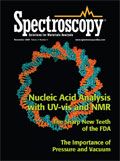A Stronger FDA: What Does It Mean for You?
The FDA, like the IRS or the DMV, is one of those governmental agencies that by its very nature can inspire many with at least a hint of dread. For one thing, it can often seem that they are only heard from when something bad is happening (that is, you haven't paid your taxes, you haven't paid a speeding ticket . . . or there is an inspection of your facility on the way).
The FDA, like the IRS or the DMV, is one of those governmental agencies that by its very nature can inspire many with at least a hint of dread. For one thing, it can often seem that they are only heard from when something bad is happening (that is, you haven't paid your taxes, you haven't paid a speeding ticket . . . or there is an inspection of your facility on the way).

David Walsh
Here at Spectroscopy, we leave the politics of the "Bush FDA" versus the "Obama FDA" to others, and instead focus on what is currently happening and how it impacts the laboratories and the daily work of our readers. In other words, we try to answer the question, "What does it all mean for me?" With this in mind, columnist Bob McDowall, one of the foremost experts on not only the FDA and its policies and regulations, but compliance in general, presents his take on the recent FDA Modernization Act and the posture of the FDA and its new commissioner, Margaret Hamburg, in general. Admittedly, the title of his column gives away his point of view to a large degree, as "The Tiger Has Sharp New Teeth" tells you where he thinks the FDA is headed. Tougher enforcement, shorter compliance times, and more appear to be on deck, but as always, Bob has answers and advice on how to succeed in this new environment. For whether you believe tougher regulation and enforcement is a good thing or a bad thing, the fact is that the laboratories of many readers will be forced to confront the coming changes regardless.
At Spectroscopy, we have always made it our mission to bring readers practical, nuts-and-bolts information to help them in their daily work, and this column, aimed at those on the frontlines of materials analysis, is just one more example of this mission in action. We hope you find this column and the other columns and technical research in this issue useful, and as always, feel free to contact myself or any one of our staff members at the e-mail addresses listed.
Enjoy the issue.

David Walsh
Editor-in-Chief

Newsletter
Get essential updates on the latest spectroscopy technologies, regulatory standards, and best practices—subscribe today to Spectroscopy.
Scientists Use AI and Spectroscopy to Detect Fake Honey in Bangladesh
July 29th 2025Researchers in Bangladesh have developed a rapid, non-destructive method to detect honey adulteration using UV-Vis-NIR spectroscopy paired with machine learning. Their findings could protect consumers and support food quality enforcement.
Random Forest Algorithms Gain Ground in Biomedical Signal Analysis and Chemico-Biological Research
July 29th 2025A new review article highlights the growing use of random forest machine learning (ML) models in biomedical signal analysis, emphasizing their potential for detecting cell damage, assessing toxicity, and advancing diagnostic classification.